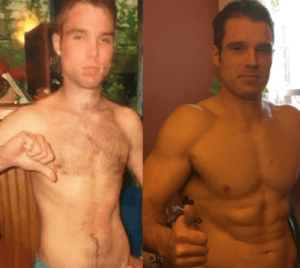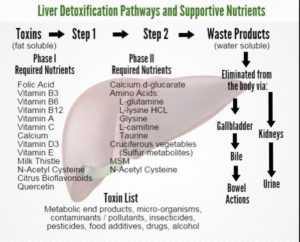Mast Cell Modulation – The Missing Link in Autism
 Autism is one of the most complicated disorders that exists. It involves imbalances in SEVERAL areas in the body, AND an over-reactive immune system. For this reason, most practitioners are left baffled when examining an autistic child. As a result, they don’t actually TREAT autism, instead, they help patients manage the symptoms.
Autism is one of the most complicated disorders that exists. It involves imbalances in SEVERAL areas in the body, AND an over-reactive immune system. For this reason, most practitioners are left baffled when examining an autistic child. As a result, they don’t actually TREAT autism, instead, they help patients manage the symptoms.
Why do I believe I there’s an answer to autism? Simple, I reversed my own “incurable” autoimmune condition, and overcame most of the underlying issues consistently found in autism, The main difference being, I did it as a young adult.
Here is a pic of me shortly after being diagnosed with several “incurable” conditions, and then me finally healthy. Though it took 16 years, these types of things are possible.

After thousands of hours of research, 16 years of real-life experience, and endless trial and error, I’ve finally put the autism puzzle together in 4700 words, with 60+ supporting studies. As you’ll see in this meta-analysis, I’ve summarized the underlying issues in autism, provided 10 mast cell modulation techniques, and then covered frequently asked questions. First things first, here are the key underlying issues found in nearly ALL autistic children. Please note, they are in no specific order.
Underlying Issues Found in Autism
Methylation Imbalance
Research has shown that autistic children have poor methylation which leads to oxidative stress and genetic expression. As shown in studies, methylation has an inverse correlation with gene expression. (1) This undermethylation found in ASD is typically caused by a lack of the specific nutrients needed to support the methylation cycle. Due to the fact that the methionine synthase reaction relies on B12, folate, and the reduced folate carrier, a lack of any one of these components will ultimately impair methylation. In a recent study, it was found that autistic children lack most of the nutrients needed to support this cycle, particularly: methionine, S-adenosylmethionine (SAM), S-adenosylhomocysteine (SAH), adenosine, homocysteine, cystathionine, cysteine, and oxidized and reduced glutathione. (2)
Heavy Metal Toxicity
There’s an obvious issue with metal detoxification in autism. It’s been shown in studies repeatedly that autistic children have high levels of metals (12, 62). Also, it’s been shown that expressions in certain genes(MTHFR, PONI) may create a hypersensitivity to specific metals (3). Add the two together, and you can see why heavy metals are such an issue for autism. In a recent study, the results suggest very strongly that individuals with a diagnosis of ASD have extraordinarily high levels of aluminum in their brain tissue. In addition, it suggests that aluminum is pre-eminently associated with non-neuronal cells including microglia and other inflammatory monocytes. (4) Unfortunately, it’s not just aluminum that is the problem, it’s mercury, cadmium, lead, and copper too! (5,11)
In a comprehensive review of all current studies, the vast majority (74%) suggest that mercury is a risk factor for ASD, revealing both direct and indirect effects. The preponderance of the evidence indicates that mercury exposure is causal and/or contributory in ASD. (6) What does the rest of the science really say about metals and autism spectrum disorder? 80% of the independent tests have concluded that metal toxicity is a causative factor in the development of autism, but only 10-20% of corporate funding studies have found a correlation (7). Sound a little fishy to you too?
The real question is, with so many studies linking heavy metals to autism, why isn’t anyone investigating this further? Simple, a conflict of interest is preventing further research into autism due to the financial consequences for the industries responsible. This is not an opinion, this was actually the conclusion of 10 physicians after a systematic review of ALL of the research on autism. (7) Their conclusion was so stunningly accurate versus all other studies, they probably got pressure to remove it, since I see it was later retracted.
Low Glutathione Levels
Oxidative damage is the leading cause of genetic stress, which has been shown to be a significant issue in autism. Why would this genetic stress be occurring? One reason is insufficient glutathione in the body. A recent study demonstrated the correlation between glutathione and oxidative stress in autism. (8) It was found that low glutathione levels may be correlated with the chronic inflammatory response we see in ASD due to the increased oxidative stress. In addition, low blood levels of glutathione are so common in autism, some have claimed it as a valuable tool in diagnosing autism. (9)
So what if we just started giving kids with autism a glutathione supplement? Well, a recent study showed improvement in patients with autism who were supplementing with glutathione.(10) The correlation of this finding of low intracellular glutathione, IL-2 and IL-15 levels, may indicate the underlying cause for NK cell dysfunction in a subset of autistic children.
Mineral Deficiencies
At the heart of autism symptoms is a severe mineral to metal imbalance (11). Unfortunately, when toxic metals are high, then mineral absorption is low. Add the dietary challenges present in autism, and it’s the perfect recipe for SEVERE mineral deficiencies. In fact, autistic children have been shown to be deficient in just about every essential mineral. First and foremost magnesium (12), then zinc (13), selenium and then trace minerals as well.
What happens when you give autistic kids minerals? Well, in this study there was a significant improvement in 67% of autistic children supplementing with magnesium/B6 (14). In another study, it showed that treating autism with zinc helped symptoms improved (13,15, 16) I could go on and on with studies, but the reality is, autistic children have significant mineral deficiencies which MUST be addressed before many of their symptoms disappear. I will cover the best methods for addressing these deficiencies later on in this review.
Gut Bacteria Imbalance
It has been shown that autistic children have bacterial imbalances in their stool.(17, 18) This leads to issues in the gut which promote systemic inflammation via the gut-brain axis. Why are these bacterial imbalances occurring? That issue is debatable, but what isn’t is the fact that this bacterial imbalance must improve for symptoms to improve. In many cases, severity of gut complaints in autism are directly linked to severity of the condition(63). What does this mean? If you balance the gut, many of the symptoms should improve significantly. In one study, a bifidobacteria based probiotic helped autistic children with both behavioral and GI symptoms.(19) In another study, prebiotic supplementation also lead to improvement in autism symptoms.(20) In short, if you can balance the gut, you modulate the inflammatory response, which many believe is the driving force behind autism.
Low Bifidobacterium Levels
Bifidobacterium is a species which is critical to health in humans. Bifido is responsible for regulating histamine, creating GABA, keeping mast cells calm, reducing IL-6 levels, and inducing several anti-inflammatory responses. As expected, bifidobacterium has shown to be low in autism.(21, 22) In one study, they even referred to the bifidobacterium deficiency as a “striking depletion”(23). In short, I believe this is a VERY important issue to address if you want to see long-term results. It was essential to modulating my immune response.
Are there any studies which show improvement in autism from bifidobacterium supplementation? Yes, there is! In a pilot study done just months ago, it was found that bifidobacterium/colostrum supplementation reduced autism symptoms! (24) To quote the study: “Some participants on both treatments saw a reduction in the frequency of certain GI symptoms, as well as reduced occurrence of particular aberrant behaviors. Improvement may be explained by a reduction in IL-13 and TNF-α production in some participants”. Although limited conclusions can be drawn from this small pilot study, the results show that further investigation is needed into the use of bifidobacterium for autism.
Another study I find interesting found that bifidobacterium breve supplementation lead 173 genes to change their expression. I found this interesting because I’ve personally seen profound effects from high dose bifidobacterium, and autism has been shown to be related to altered gene expression.
Phase 2 Liver Detox Impairment
Phase 2 liver detoxification involves several processes critical to overall health. The most important are methylation, acetylation, and sulfation. Phase 2 detoxification is process where the liver adds additional chemicals like glycine, to toxins that have already been processed in phase 1. This makes them water soluble and allows them to be eliminated from the body.
When a deficiency in the phase 2 process occurs, this leads to the recirculation of toxins which causes increased oxidation. In a child with autism, the brain blood barrier integrity is compromised (25), and mast cells are over activated. This leads to a situation where both neurotoxins and inflammatory chemicals (cytokines, etc) are easily able to pass the BBB and effect the brain.
It was found that children diagnosed with autism have on average serum sulfate levels that are reduced 33% versus controls (26). This is due to problems in the sulfation cycle. In addition, as mentioned prior, ASD patients also show significant undermethylation (27). These are just a couple example of how autistic patients have impaired phase 2 detoxification processes. Problems in phase 2 detoxification are likely due to deficiencies in the nutritional components these processes depend on. All of the nutrients required for proper phase 2 detoxification are listed in the image below. 
GABA-Glutamate Imbalance
GABA has been shown to be a novel therapeutic target for neurodevelopmental disorders (28). Due to it’s counterbalancing effect on histamine, protective effect on gene expression, and other important factors, it’s critical to health.
In autism, GABA levels are typically low (29, 30), which as a result, increases glutamate and histamine. Both of these are considered excitatory neurotransmitters, and without GABA providing it’s inhibitory effect, levels get out of control. This GABA imbalance can then lead to ASD symptoms (31) like behavioral changes, sleep disturbances, allergic reactions, and other issues.
Deficiency in Amino Acids
Autistic patients have shown to be low in amino acids which are critical to proper detoxification and immune function. One of the most important is glutamine. Little do most know, glutamine is the most abundant amino acid in the body and can have a profound effect on autism(32). It indirectly influences inflammation by increasing GABA and reducing glutamate, two neurotransmitters shown to be imbalanced in autism (32).
The levels of glutamine are directly correlated with the perceived stress the body is experiencing. If glutamine levels are adequate, GABA is stable, promoting relaxation and a reduction in perceived stress. If levels are low, gut inflammation can occur (33), histamine increases, and systemic inflammatory responses are triggered.
Lastly, most autistic patients have imbalances in neurotransmitters (34). This amino acid deficiency may be caused by bacterial imbalances limiting protein synthesis, impaired acetylation, methylation imbalances, reduced transport across BBB (35), or other factors. None the less, a natural method to balancing neurotransmitter function may be essential in recovery. The main amino acids which could be of benefit are: L-glutamine, L-theanine, L-carnitine (35, 36), and SAM-e. All of these indirectly reduce histamine by supporting GABA production.
Connecting All the Dots
After reading hundreds of studies on autism, I asked myself a novel question. Now that we’ve identified most of the problems found in autistic children, what do ALL these problems have in common?
Simple, ALL OF THESE PROBLEMS lead to elevated histamine and mast cell degranulation, which as a result, increase inflammation AND gene expression! Therefore, all of the treatments MUST reduce histamine and stabilize mast cells, which will then positively influence inflammation and gene expression.
Why does this really matter? Because if we could modulate mast cell activity and reduce histamine levels in the body, we may be able to reverse autism! Sound exciting? Well, this is where the two most important parts of the puzzle come in: MAST CELLS and HISTAMINE. For the rest of this review, these will be our main focus.
Mast Cells and Autism – The Missing Link
What are mast cells? Well, in simple terms, they’re our “cellular watchdogs” which alert the body anytime a perceived threat is present. For this very reason, the chemicals they secrete alter the chemistry of the ENTIRE BODY. Mast cells are meant to have this much control over the body because the chemicals they secrete are essential to survival. The problem comes when the mast cells are chronically over-activated, and the inflammatory chemicals build up in the body. This is exactly the case in autism, and to make matters worse, they have 10x the population of mast cells versus health subjects (37).
How to Control Mast Cell Activation in Autism
So how do you control mast cell reactivity in autistic children when copious stressors are present? Simple, you use various mast cell modulation techniques TOGETHER in an ALL OUT WAR ON HISTAMINE. This will FINALLY allow the mast cells to calm down, since they degranulate and repopulate relative to current blood histamine levels(63). As stated prior, mast cell modulation is the FIRST STEP in healing autism. By attempting to fix any other issue first, you traumatize your immune system even further, which increases mast cell population, making your problems even worse.
Do you see why fighting autism is a trap without mast cell modulation strategies? Hopefully, with this ground breaking review now published, the concept will soon be widely accepted by the scientific community.
Refer below for the exact strategies I USED to overcome histamine intolerance and mast cell activation.
Mast Cell Modulation Strategies
Remove Histamine Producing Foods
Remove dietary sources of histamine with strict adherence to the low histamine diet. This has been proven in studies to dramatically reduce plasma histamine levels in the body. (38) After successfully adhering to the diet for 10 days, evaluate which foods you’re still craving and remove them also from the diet. In most cases, when chronically ill, the foods you REALLY crave either feed bad bacteria, are hidden food sensitivities or do not digest properly. Either way, both of these scenarios will increase histamine in the body which we do NOT want. The reality is, gut bacteria influence eating behaviors,(39) so just keep that in mind at all times!
Restore DAO Enzyme Levels
Histamine can build up in the gut and blood. To remove the histamine from the blood, you must focus on increasing the natural production of DAO enzyme. Rather than just taking DAO enzyme supplement, you are best served to supplement with a chelated magnesium glycinate product (I used “Doctors Best” brand). This will naturally increase DAO production, which can then reduce histamine in the blood.(40) Studies have shown by supplementing with magnesium and B6, autism symptoms were reduced. Lastly, as stated prior, make sure to adhere to the low histamine diet. Studies have shown that the diet not only reduces symptoms, but also increases serum DAO levels.(41)
Replace Lost Bifidobacterium
Histamine builds up in the blood, but also in the gut. That is where it can cause many of the symptoms of histamine intolerance. To reduce levels of histamine in the gut, you must increase the bacteria responsible for breaking it down. In humans, Bifidobacterium is the species primarily responsible. The main strains involved in histamine degradation are bifidobacterium longum (42), b. breve, b. bifidum, and b. lactis. In addition, as mentioned prior, bifidobacterium strains have been proven to help with autism.
Treat Chronic Infection
Histamine levels are directly linked to immune health in the body. If your immune system is fighting any infection, it will increase mast cell degranulation. This is the process in which mast cells release histamine, which makes autism symptoms flare up. To reduce histamine release in the body, you must treat the underlying infection if there is one present. This is best accomplished though after stabilizing mast cells with modulators prior.
Mast Cell Modulators
Since chronic infection is one of the hardest parts to get rid of, it’s best to focus FIRST on mast cell modulation techniques. This means using various supplements to control your body’s response to environmental stressors. In short, you want to make your body think that nothing is wrong, even if it’s battling infection, nutrient deficiency, etc.
By supplementing with small amounts of several different modulators, you can start to correct some of the root problems while dramatically reducing inflammation. In my experience, the most effective histamine modulators are bovine colostrum, Bifidobacterium, chelated magnesium glycinate, vitamin K2/D3, trace minerals, luteolin, etc.. Please note, I will list all of the supplements which are scientifically proven to help with mast cell activation in the FAQ section.
Increase GABA Levels
Next you want to decrease histamine by increasing it’s opposite, GABA! To increase levels, you do NOT want to take the GABA supplement. Instead, you want to consume precursors like l-glutamine (43). If consumed on an empty stomach separate from other amino acids, each of these will produce GABA in the brain. Why does this matter again? Simple, when GABA increases, histamine generally declines (44).
Remove Hidden Histamine Sources
If you are taking any supplements other than what I listed in the FAQ, you may want to consider stopping. Little do most realize, many supplements they’re taking could be activating mast cells. This was the case for me until I came to my moment of clarity. In short, anything NOT on that list is not needed until you get mast cells response under control. Once your symptoms start to improve significantly, you can add supplements based on remaining symptoms.
Detoxify Heavy Metals
If the autistic child has little gut complaints, but still severe symptoms of ASD, metal detoxification may be the source of mast cell activation. It has been demonstrated in countless studies that metal toxicity is an issue in autism, but recent science has shown these metals also activate mast cells (45, 46) In short, to reduce mast cell sensitivity, detoxification of heavy metals is imperative if toxicity is indeed present. In my experience, broken cell-wall chlorella (47) and diatomaceous earth/silica (48) have been the gentlest, yet most effective way to remove toxic metals.
Restore Antioxidant Levels
Mast cell reactivity has been shown to be correlated with blood levels of glutathione (49). What does this mean? It means your antioxidant defenses directly influence your immune system’s response to environmental stressors. In ASD, the body is in “oxidative debt” and therefore over-reacts to any new toxic stressors. Once it has sufficient antioxidants, reactions start to normalize. You can see this is true with studies that show improvements when serum glutathione was increased. To increase antioxidant defenses, in my experience, the best methods are: using liposomal glutathione (50) (one week loading phases, then steady dose), and juicing antioxidant rich vegetables. Once the GSH levels get back up, the toxic burden reduces, which in turn stabilizes mast cells.
Moderate Meat Consumption
Meat protein can convert into histamine in the body. In addition, those with chronic illnesses typically have bacterial imbalances which can effect protein digestion. This means that much of the meat may pass through the intestines undigested, creating histamine as it putrefies. How do you fix this issue? You eat meat a maximum of 1x per day and replace it with beans and whey protein (no fillers) when possible. When eating meat, it’s also best to consume fresh ginger root with honey directly prior. The ginger contains a proteolytic enzyme which can assist in protein breakdown (51).
Avoid Mast Cell Triggers
Mast cells can be set off by a number of things: sudden temperature changes, intense exercise, spices/herbs used on food, arguments, expectations of self, inconsistent sleep patterns, food additives, chemical fragrances, mold allergies, bacterial imbalances, lack of fiber, not enough sunlight, food sensitivities, etc. Try to avoid ALL of these histamine traps at ALL costs. Keep in mind, you can reduce histamine in one area of your life, and you subconsciously will attempt to replace it with something else that produces histamine. Why? Remember, because histamine produces wakefulness (52) and that can be quite addictive (53).
Frequently Asked Questions
What are the best supplements for mast cell modulation?
In my experience, the supplements I listed are the only ones you need to effectively reduce histamine and modulate mast cells. Here is a detailed list with each supplements mode of action backed by research: l-glutamine (increases GABA (43), maintains gut wall integrity (54)), bifidobacterium ONLY probiotic (breaks down histamine(55), modulates immune system(56, 57), modulates mast cells(58)), chelated magnesium glycinate (modulates mast cells(59, 60), indirectly produces GABA(61), maintains DAO levels(62)), liposomal colostrum (modulates immune system(63, 64, 65), liposomal glutathione (reduces oxidative stress(66), modulates immune system(67), low in autism(68)), Vitamin D3/K2 (stabilized mast cells(66), reduces histamine release(67, 68), autism typically deficient (31, 32), silibinin (mast cell modulation (32, 34, 35), reduced oxidative stress(36), luteolin (2, 55), and trace minerals (mast cell modulation(33)).
Please note, autistic children are VERY sensitive to GABA altering agents. All GABA precursors are best used at the lowest dose first and increased until improvement is seen. Also, there WILL be a sweet spot/ideal dose for all of these mast cell modulators, more is NOT necessarily better. The one exception to this rule is bifidobacterium (probiota bifido by Seeking Health – ONLY bifido product I use). This is one supplement which has no toxicity and with mast cell activation present, the more you consume the better.
Why are current treatment methods for autism generally ineffective?
In a recent study, they stated that “a lack of distinct pathogenesis and reliable biomarkers hampers the development of effective treatments for autism.(42)” Though I agree with this, the problem is, it’s based on the idea that everyone with autism is the same biochemically, and they all have the same root cause. This is simply not true. Remember, “autism” is NOT a disease, it is a man made word used to explain a grouping of symptoms. Just because a subgroup of people are all experiencing similar symptoms, it does NOT mean they all have the same root cause.
What is the next step AFTER mast cells are under control?
After mast cells are completely under control, you should notice a significant reduction in symptoms. Your next step after that depends which symptoms still remain. Though there’s a myriad of issues which can contribute to symptoms, gut health is usually the first place to start. Countless studies have shown gut bacteria abnormalities in children with autism (55). In addition, there is no denying that the gut-brain axis is dysfunctional in ASD and must be regulated to restore health.
If gut symptoms are present, typically, it’s caused by bacterial overgrowth and/or parasitic infestation. The more severe the symptoms, the less likely you are dealing with JUST a bacterial overgrowth. If the child is not showing symptoms of gut issues or food sensitivities (56), then heavy metals and/or impaired detoxification/methylation/sulfation may be to blame.
What lifestyle factors can influence mast cell activation?
The most difficult lifestyle change is usually diet. If you can get your child to embrace the low histamine diet, with an emphasis on primarily plant-based foods, you are WAY AHEAD of the game! Keep in mind, this may take some creativity and cheerleading on your part! Outside of diet, the other main lifestyle factors that contribute to mast cell activation are: inconsistent sleep patterns, temperature extremes, poor emotional coping skills, and really just OVER-DOING anything in life. If you want stable mast cells, MODERATION is the key.
Are dietary changes necessary to see improvements in autism?
The ideal diet for a child with autism is: 10% animal products, 90% plant based foods; low histamine foods ONLY with DAILY intake of foods containing sulforaphane.(broccoli, cabbage, brussel sprouts, cauliflower, etc.). This phytonutrient has been shown to be important in regulating gene expression, which may be why it had such a profound effect on autism in a recent study (57).
Lastly, I would remove all processed foods, eat organic produce, and avoid anything containing artificial chemicals, bulking agents, or food additives. Unless you eliminate ALL sources of mast cell activation, it’s impossible to ever know what’s really causing it. Eventually, once you start to reintroduce things back into your child’s diet, the negative effects will be MUCH EASIER to recognize because of the time away from these irritants.
How is mast cell activation involved in creating ASD symptoms?
Well, first of all, autistic children typically have over active mast cells, and 10x as many as others (63). This means they secrete far more inflammatory chemicals (histamine, cytokines, etc.) than usual. When histamine levels are elevated, the blood brain barrier dilates (58), allowing these inflammatory chemicals to cross in large amounts. These inflammatory chemicals then causes neuroinflammation, which lead to behavioral symptoms. This cycle of mast cell degranulation, high histamine, and neuroinflammation, I believe, is the first issue which must be addressed before any sustained improvement can occur. Without doing do, the immune system remains paralyzed in over-reactivity.
Any other scientific studies linking mast cells with autism?
There are several studies but I will highlight a few. First off, autistic children showed significant improvement in behavior after taking luteolin (59). The main mode of action of luteolin is that it reduces neurological inflammation by stabilizing mast cells. These results makes it obvious that the behavioral symptoms are linked to neuroinflammation, and if we had a stronger modulation method, we could further reduce symptoms.
Lastly, I want to provide proof that mast cell modulation techniques can work in autism, even without treating the underlying problem/root cause. A good example of this is CBD oil. Cannabidiol has shown to improve behavior in autistic children in 61% of the cases(60), and even higher in others studies(61). The main mechanism of action for cannabidiol is controlling mast cell release of inflammatory chemicals, and increasing anandamide. In short, by altering chemical balance, it tricks the body into thinking everything is fine, when it really isn’t. These results prove it IS POSSIBLE to manipulate the immune system response in autism via modulation of mast cells, and by doing so, symptoms can improve significantly.
Summary – A New Perspective on Autism
As you can see, there are so many underlying imbalances in autism, it’s impossible to correct them all at once. In addition, when you try to work through these problems while the body is under severe stress, it over-reacts, worsening symptoms. This is the trap most parents find themselves in when trying to treat their child’s autism.
For these reasons, recovery from autism DEMANDS a diverse approach which targets mast cell activation first and foremost. One which gently improves various areas of concern while following two core principles: reduce histamine, and stabilize mast cells.
The fact is, you MUST address mast cell activation FIRST before working through any of the problems. This will trick the body into thinking there’s NO PROBLEM when there really is. Though you will need to treat the root cause eventually, you MUST decrease mast cell population and reactivity first. This will reduce histamine and the other inflammatory chemicals thought to be responsible for many of the symptoms of autism.
I know this is A LOT of information, but if you know someone with autism, this post COULD CHANGE THEIR LIFE. Please do not hesitate to get in touch with any questions.
Thanks for reading, and happy healing everyone!
Matt Nedin
EndSickness.org
Phone: (734) 846-8619
Email: endsickness@gmail.com







